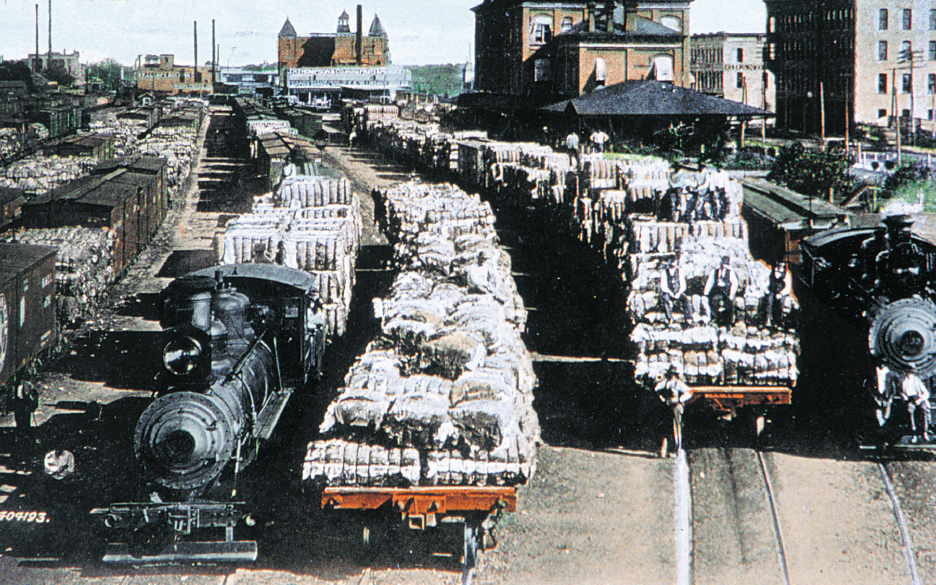The Emergence of a Labor Movement
The problem of industrial labor entered Americans’ consciousness dramatically with the Great Railroad Strike of 1877. Protesting steep wage cuts amid the depression that had begun in 1873, thousands of railroad workers walked off the job. Broader issues were at stake. “The officers of the road,” reported strike leader Barney Donahue in upstate New York, “were bound to break the spirit of the men, and any or all organizations they belonged to.” He believed railroad companies wanted to block workers from “all fellowship for mutual aid.” The strike brought rail travel and commerce to a halt. Thousands of people poured into the streets of Buffalo, Pittsburgh, and Chicago to protest the economic injustice wrought by railroads — as well as fires caused by stray sparks from locomotives and injuries and deaths on train tracks in urban neighborhoods. When Pennsylvania’s governor sent state militia to break the strike, Pittsburgh crowds reacted by burning railroad property and overturning locomotives. Similar clashes between police and protesters occurred in other cities across the country, from Galveston, Texas, to San Francisco.

The 1877 strike left more than fifty people dead and caused $40 million worth of damage, primarily to railroad property. “It seemed as if the whole social and political structure was on the very brink of ruin,” wrote one journalist. For their role in the strike, many railroad workers were fired and blacklisted: railroad companies circulated their names on a “do not hire” list to prevent them from getting any work in the industry. In the aftermath of the strike, the U.S. government created the National Guard, intended not to protect Americans against foreign invasion but to enforce order at home.
Watching the upheavals of industrialization, some radical thinkers pointed out its impact on workers. Among the most influential was Henry George, whose book Progress and Poverty (1879) was a best-seller for decades after publication. George warned that Americans had been too optimistic about the impact of railroads and manufacturing, which they hoped would — after an initial period of turmoil — bring prosperity to all. George believed the emerging industrial order meant permanent poverty. Industrialization, he wrote, was driving a wedge through society, lifting the fortunes of professionals and the middle class but pushing the working class down by forcing them into deskilled, dangerous, and low-paid labor. George’s proposed solution, a federal “single tax” on landholdings, did not win widespread support, but his insightful diagnosis of the problem helped encourage radical movements for economic reform.
Many rural people believed they faced the same problems as industrial workers. In the new economy, they found themselves at the mercy of large corporations, from equipment dealers who sold them harvesters and plows to railroads and grain elevators that shipped and stored their products. Though farmers appeared to have more independence than corporate employees, many felt trapped in a web of middlemen who chipped away at their profits while international forces robbed them of decision-making power.
Farmers denounced not only corporations but also the previous two decades of government efforts to foster economic development — policies that now seemed wrongheaded. Farmers’ advocates argued that high tariffs forced rural families to pay too much for basic necessities while failing to protect America’s great export crops, cotton and wheat. At the same time, they charged, Republican financial policies benefitted banks, not borrowers. Farmers blamed railroad companies for taking government grants and subsidies to build but then charging unequal rates that privileged big manufacturers. From the farmers’ point of view, public money had been used to build giant railroad companies that turned around and exploited ordinary people.
The most prominent rural protest group of the early postwar decades was the National Grange of the Patrons of Husbandry, founded in 1867. Like industrial workers, Grange farmers sought to counter the rising power of corporate middlemen through cooperation and mutual aid. Local Grange halls brought farm families together for recreation and conversation. The Grange set up its own banks, insurance companies, and grain elevators, and, in Iowa, even a farm implement factory. Many Grange members also advocated political action, building independent local parties that ran on anticorporate platforms.
During the 1870s depression, Grangers, labor advocates, and local workingmen’s parties forged a national political movement, the Greenback-Labor Party. In the South, Greenbackers protested the collapse of Reconstruction and urged that every man’s vote be protected. Across the country, Greenbackers advocated laws to regulate corporations and enforce an eight-hour workday to reduce long, grueling work hours. They called for the federal government to print more greenback dollars and increase the amount of money in circulation; this, they argued, would stimulate the economy, create jobs, and help borrowers by allowing them to pay off debts in dollars that, over time, slowly decreased in value. Greenbackers, like many industrial labor leaders, subscribed to the ideal of producerism: they dismissed middlemen, bankers, lawyers, and investors as idlers who lived off the sweat of people who worked with their hands. As a Pittsburgh worker put it in an 1878 poem, it was not the money-handlers or executives at the top but the “noble sons of Labor… / Who with bone, and brain, and fiber / Make the nation’s wealth.”
The Greenback movement radicalized thousands of farmers, miners, and industrial workers. In Alabama’s coal-mining regions, black and white miners cooperated in the party. Texas boasted seventy African American Greenback clubs. In 1878, Greenback-Labor candidates won more than a million votes, and the party elected fifteen congressmen nationwide. In the Midwest, Greenback pressure helped trigger a wave of economic regulatory actions known as Granger laws. By the early 1880s, twenty-nine states had created railroad commissions to supervise railroad rates and policies; others appointed commissions to regulate insurance and utility companies. Such early regulatory efforts were not always effective, but they were crucial starting points for reform. While short-lived, the Greenback movement created the foundation for more sustained efforts to regulate big business.
COMPARE AND CONTRAST